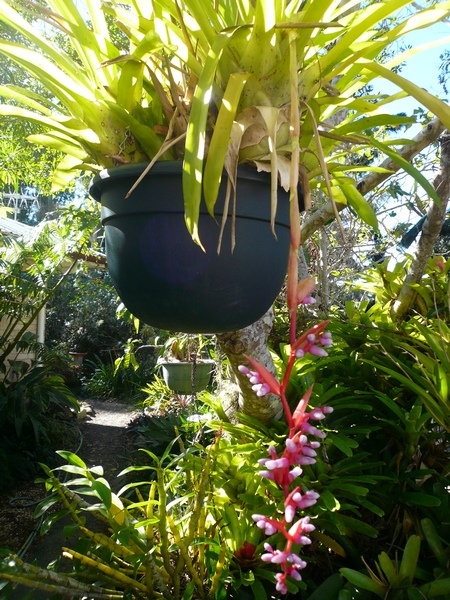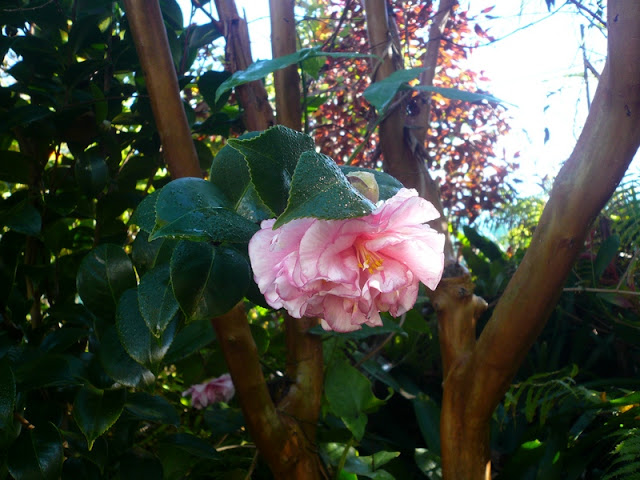Rose and blue; playing games... good morning;
Red from the brilliant berries of Ardisia.
Ardisia can be invasive, as it seeds easily.
It might be a declared weed in Australia.
Pink and skyblue flowers of Bromeliad Aechmea Apocalyptica.
People don’t notice whether its winter or summer when they are happy.
Anton Chekhov
Orange for mandarins; the trees are full;
Wonder and mystery are obliged to knowledge. ©Titania
Blush Pink, Hibiscus; winter cold colours the Hawaiian white elephant ear a blush pink.
Red and Blue Nidularium, Bromeliad
Sprigged Red and white, Cherie returns to life in winter;
You need chaos in your soul to give birth to a dancing star.
Friedrich Nietzsche
Rose, Petunia, many pots are planted with annuals for winter cheer;
Light, seeking light, doth light of light beguile
Love's Labor's Lost Act 1. scene 1, William Shakespeare
Red and Purple flowers of a Bromeliad, Neoregelia
Those who contemplate the beauty of the earth find reserves of strength that will endure as long as life lasts.
Rachel Carson
Looking up to an ever changing sky...
Red Scots bonnets, these make a tasty chili jam. The first I tried were so hot I did not want to use them.
Now I find them very agreeable for chili Jam. I do not use them fresh!!
They grow well on small bushes and are very prolific.
For my chili jam I use the whole chilis just cut in two. I cook them in vinegar and sugar until soft, blend them and cook again in enough vinegar and sugar and a little salt to give an agreeable taste of hot and sweet , until syrupy. Fill in glasses and keep in the fridge. I sometimes mix chili jam and organic tomato sauce, like ketchup to use with certain dishes.
The Scotch bonnet (Capsicum chinense) is a variety of chile, similar to, and of the same species as the habanero. The shape is slightly different from the habanero and the Habanero when ripe is orange while the Scotch bonnet when ripe is red. The Scotch Bonnet grows mainly in the Caribbean islands while the habanero grows mainly in Latin and North America. They are both quite hot (wear gloves when processing them) but have distinct and different flavors. Once you get over the initial blistering heat, the intense citrus-like flavor will win you over. Words such as hellish, blistering, and incendiary are used to describe the heat.
The Scotch bonnet has a shape that is similar to that of an old-fashioned Scottish bonnet. Most Scotch bonnets have a heat rating of 150,000–325,000 Scoville Units. They are supposedly not as hot as a habanero pepper but when you try a Scotch bonnet, you will feel the same type of fire as eating a habanero pepper. Scotch bonnets are used in many different sauces worldwide. They are also known to cause dizziness, numbness of hands and cheeks as well as severe heartburn, if eaten raw. After preparing chilis it is very important to avoid contact with the eyes or any sensitive skin - even washing the hands may not be enough to remove the capsaicin that gives it its hot taste.
Mauve, perennial Salvia; now available in punnets in many different, even varigated colours, easy to grow from cuttings for borders as they grow about 30 - 40 cm high.
Dark Pink, Bromeliad Aechmea recurvata var benrathii - a stunning mini bromeliad with a beautiful colour change.
Tree Art;
Blue and Silver,
Winter sunlight provides a mellow, watercolour look; challenging above all a brilliant sky blue hugging the land…©Titania
Believe it or not:
A garden speaks the language of all poeple, no matter to faith, nationality or age, a garden holds all the answers to life.
©Titania
Blue and Silver,
Winter sunlight provides a mellow, watercolour look; challenging above all a brilliant sky blue hugging the land…©Titania
Believe it or not:
A garden speaks the language of all poeple, no matter to faith, nationality or age, a garden holds all the answers to life.
©Titania
http://pelluciidityblogspotcom.blogspot.com.au/ Poetic Takeaway's; a trivial world of words.
Poet














































